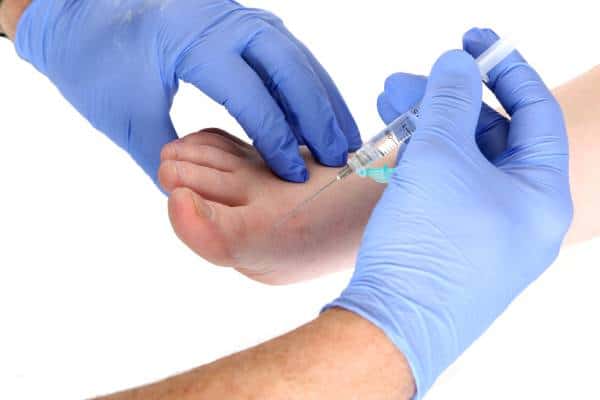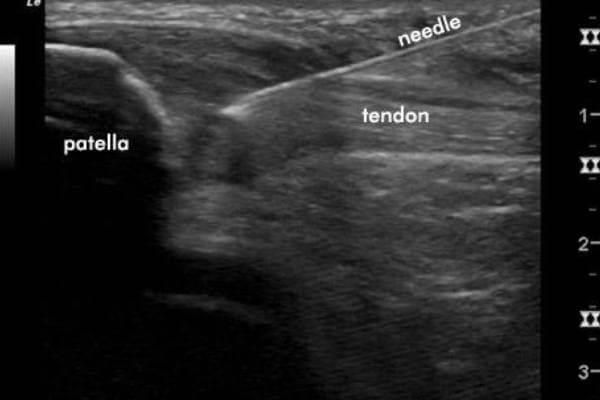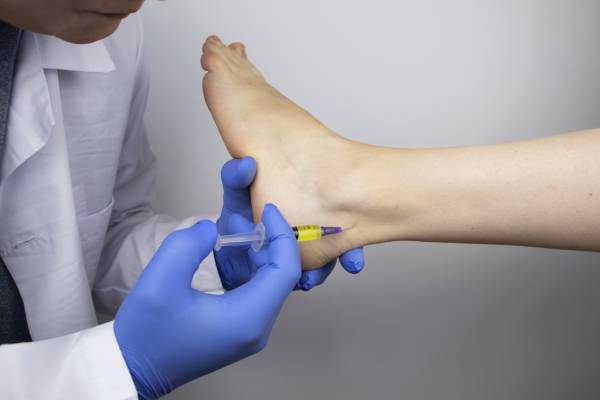Injection Therapy
Injection Therapies for Foot and Ankle Health
Whether you’re experiencing discomfort from Morton’s neuroma, Achilles tendinopathy, plantar fasciitis, or other related issues, our team uses advanced techniques like aspiration, tendon fenestration, and cortisone injection to target the underlying causes. All procedures are performed under ultrasound guidance to ensure that the right area is treated.

Types of Injection Therapy at the Ankle, Foot and Orthotic Centre
Aspiration

What is Aspiration?
Aspiration involves using a needle to remove excess fluid or other materials from a joint, tendon, or soft tissue. This technique is often used to alleviate swelling and pressure that can cause pain and discomfort. It is commonly performed for conditions such as bursitis, joint effusions, and tendonitis, where fluid build-up can lead to inflammation and limit movement.
The procedure is minimally invasive, typically performed under local anaesthesia to ensure patient comfort. After the fluid is removed, it may be analysed for signs of infection or other issues, and in some cases, corticosteroid or other medications may be injected into the area to further reduce inflammation and promote healing.
Aspiration therapy can help reduce pain, improve function, and prevent further complications, allowing patients to return to their regular activities with greater ease.
Tendon Fenestration

Ultrasound image above shows a thick insertion of the plantar fascia
What is Ultrasound Guided Tendon Fenestration?
Tendon Fenestration involves passing a needle through the abnormal tendon multiple times (20-25 times) to change a chronic degenerative process into an acute condition that is more likely to heal.
In the Foot and Ankle this is beneficial for Achilles Tendinopathy and Plantar fasciitis. It is very important that the region is numb for this procedure with the use of local anaesthesia. Ultrasound guidance ensures that the needle is passing through the areas of tendon degeneration.
The needle is passed through the plantar fascia around 20 – 25 times to change the chronic degeneration of the tendon into a more active acute response.
- Chiavaras, M.M. and J.A. Jacobson, Ultrasound-guided tendon fenestration. Seminars in Musculoskeletal Radiology, 2013. 17(1): p. 85-90.
How does Ultrasound Guided Tendon Fenestration Help?
- Tendon Fenestration is thought to stimulate tendon healing (1)
- Disrupts area of tendinosis this is achieved by making multiple passes through the damaged tendon (1)
- Injecting the damaged tendon causes bleeding which results in the release of growth factors (1)
Cortisone Injection

What is Cortisone Injection?
A cortisone injection is a targeted treatment that delivers a powerful anti-inflammatory medication directly to an area of pain or swelling. In podiatry, cortisone is commonly used to treat various foot and ankle conditions where inflammation is a key factor.
Cortisone (a corticosteroid) is not a painkiller — it works by reducing inflammation, which often results in significant pain relief and improved mobility.
Cortisone Injection FAQs
When Are Cortisone Injections Used in Podiatry?
Cortisone injections may be recommended when other conservative treatments such as rest, orthotics, or physical therapy haven’t provided sufficient relief.
Common conditions treated include:
- Plantar fasciitis
- Heel spurs
- Morton’s neuroma
- Bursitis
- Arthritis in the foot or ankle
- Tendonitis (Achilles, posterior tibial, etc.)
- Capsulitis or joint inflammation
What to Expect During the Procedure?
The procedure is quick and usually performed in-clinic:
- The area is cleaned and sometimes numbed with a local anaesthetic.
- The cortisone is injected directly into the affected area, often using ultrasound guidance for accuracy.
- You may feel a pinch or mild pressure, but the procedure is generally well-tolerated.
What Happens After the Injection?
- Mild soreness at the injection site can occur for 24–48 hours.
- Some people feel immediate relief, while others experience improvement over several days.
- Activity may be restricted for a short period depending on the condition being treated.
Are There Risks or Side Effects?
While cortisone injections are generally safe, possible side effects include:
- Temporary flare of pain after the injection (cortisone flare)
- Skin thinning or discolouration at the injection site
- Tendon weakening (with repeated injections)
- Infection (very rare)
Your podiatrist will discuss these risks and determine if this treatment is appropriate for you.
How Often Can I Have a Cortisone Injection?
Is a Cortisone Injection Right for You?

Get Back on Your Feet
With the help of the fully qualified team of Podiatrists and Orthotists at The Ankle, Foot, and Orthotic Centre
Visit Northcote’s friendly podiatrist. Contact us today.


